Spring and summer are perfect times to attract a wide variety of colorful migratory birds to your backyard feeders. Many birds migrate north to breed and raise their young, and they’re often on the lookout for reliable sources of food.
By providing a variety of seeds and other treats, you can attract a range of species to your yard and enjoy watching them up close. In the spring, I typically offer sunflower chips, suet, white millet, grape jelly with oranges, and hummingbird nectar. These foods draw in most of these birds listed below!
Note: I’m located in Minnesota and tried to pick birds that cross much of the continental United States to include as many people as possible!
1. Baltimore Orioles
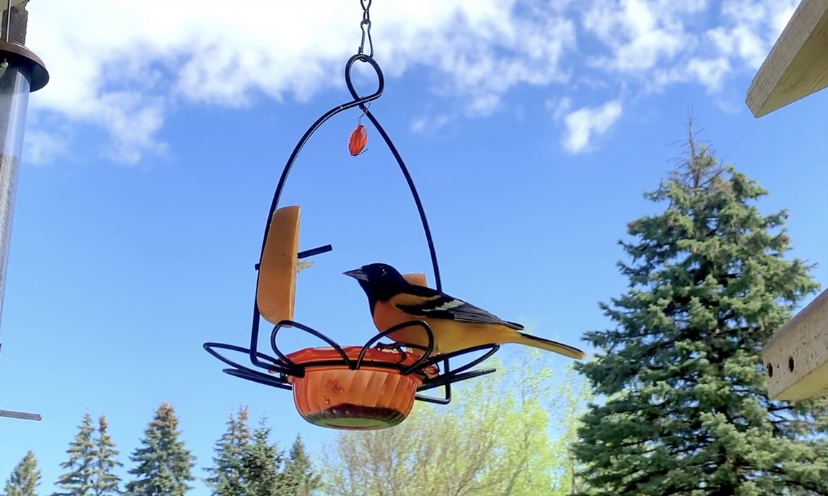
A stunning mix of bright orange, black, and white, Baltimore Orioles are a colorful migratory bird from Central America. They start their trip in April and make it to the Northern United States by late April and early-May. Their return back to Central America peaks in August and September.
The Best Food for Orioles: Grape jelly and oranges.
Your best chance to attract an Oriole is to have your feeder and their favorite foods out early to catch them during their spring migration. There are a ton of Oriole feeders you can buy. Baltimore Orioles have become increasingly common at bird feeding stations in recent years!
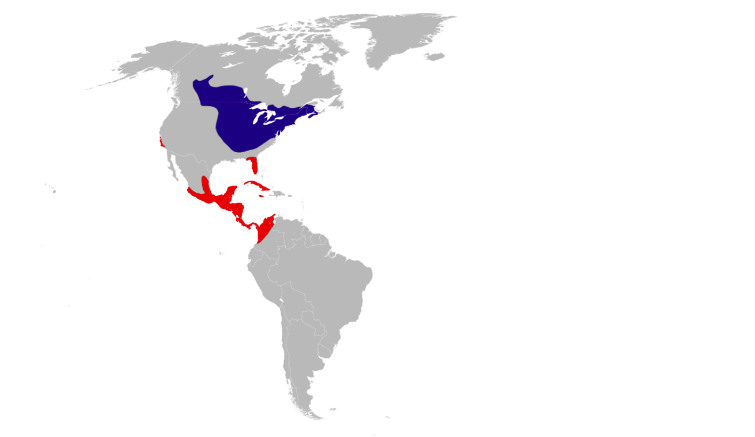
2. Chipping Sparrows

Chipping Sparrows are often the first migrant bird to visit my feeders in March and April. They’re common and widespread across much of North America (Audubon). Chipping Sparrow are small birds with a fun brown cap that hop around in bushes and on the ground at feeding stations.
If you have a bird feeder out with millet or sunflower chips, chances are you’ll see a Chipping Sparrow!
The Best Food for Chipping Sparrows: White millet
3. Eastern Bluebird

Eastern Bluebirds are a year-round resident in much of the Southern United States and are early spring migrants to the Northern parts of the U.S. (minus the Northwest). Audubon has a nice range map on their website.
Getting live mealworms and putting them on a sturdy feeder is your best bet to drawing one of these awesome birds to your feeder in the warm months.
Eastern Bluebirds are also highly likely to take up residence in nest boxes if you have space. You’ll probably have the best luck with that approach if you live in a more remote area.
The Best Food for Eastern Bluebirds: Live mealworms

Credit: rbrausse, Wikipedia
4. Gray Catbird
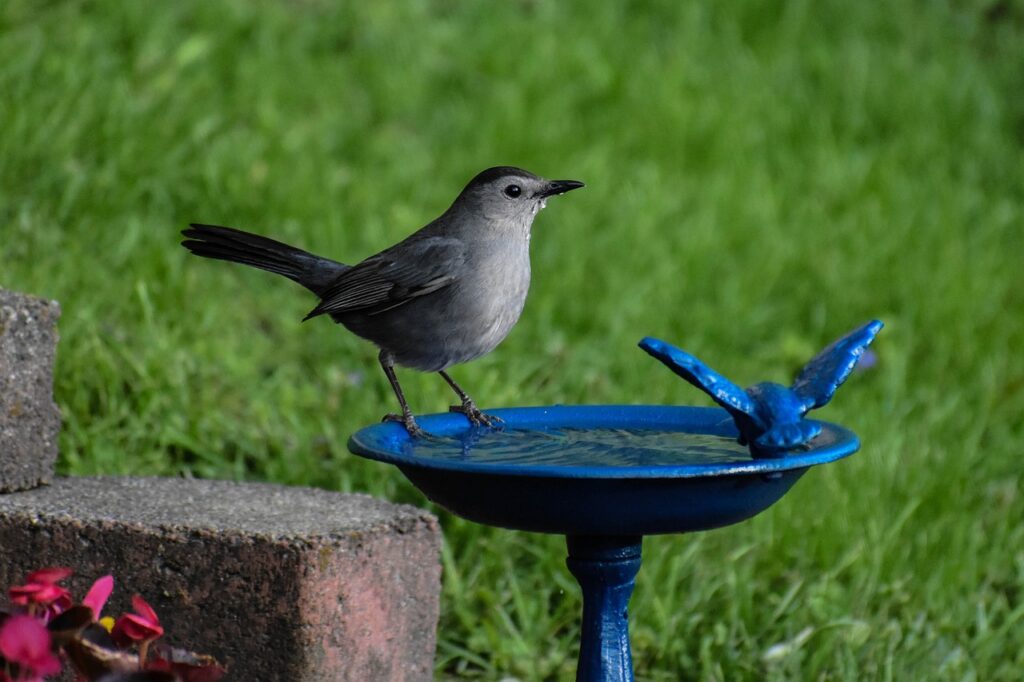
Gray Catbirds winter in the Southern United States and Central America. In the spring, you can see these fellows in bushes and sometimes out in the open or at bird feeders seeking fruit. Keep your ears open for their unique calls. According to the Cornell Bird Lab, Gray Catbirds can make a cat-like “mew” call, hence their name.
The Best Food for Gray Catbirds: Grape Jelly and Oranges

Yellow: Migration
Purple: Year-Round
Blue: Winter Range
5. Indigo Bunting
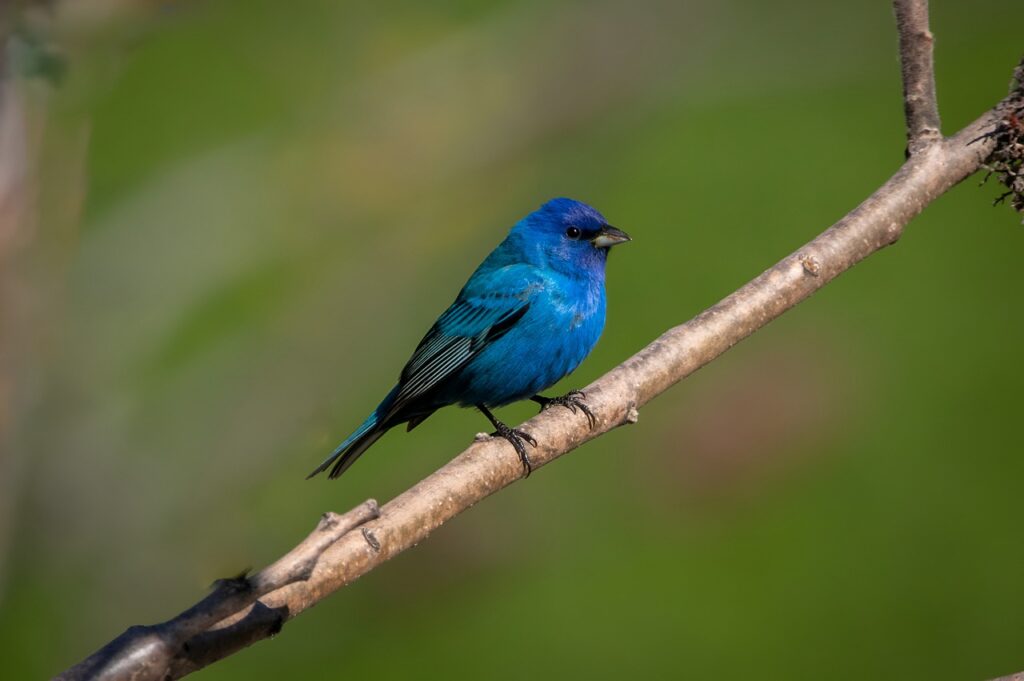
Indigo Buntings are a stunning migratory songbird in North America. Their vibrant blue color make them a standout in any backyard. I had my first ever Indigo Bunting visit this spring and it was one of the most exciting finds I’ve had at my bird feeders in a while.
They start their northern spring migration (usually traveling around 1,200 miles!) in April and return south in September.
The Best Food for Indigo Buntings: Your best bet is to have your feeders stocked in the spring with white millet and catch them during their migration.
Related Content: How to Attract Indigo Buntings to Your Yard
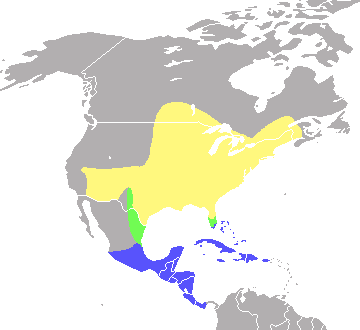
6. Red Winged Black Bird
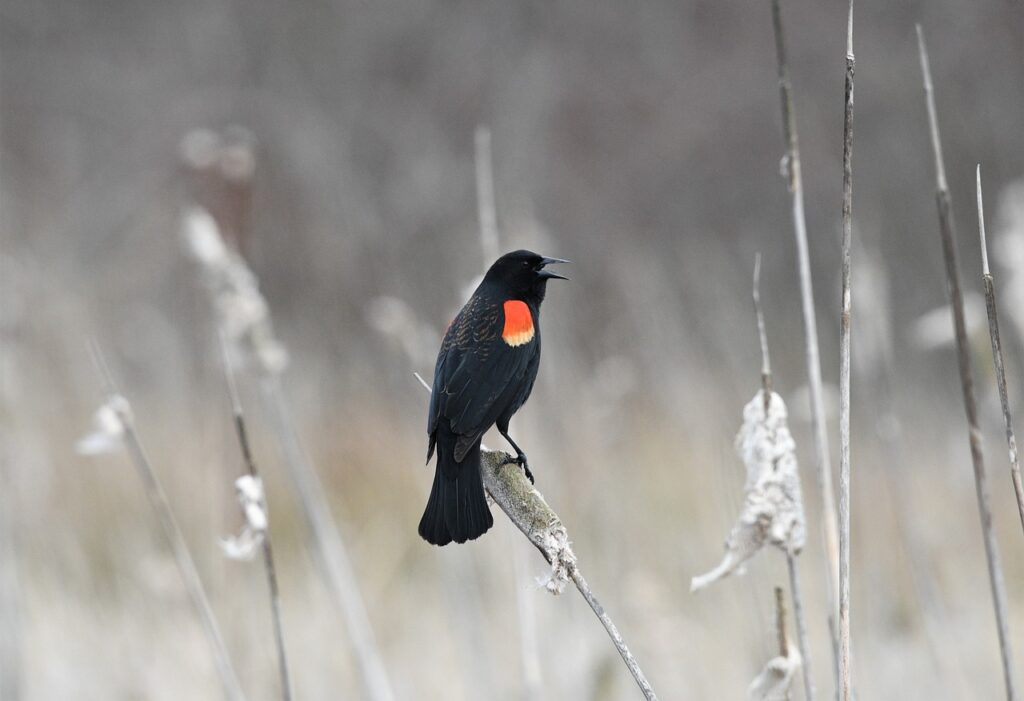
The aptly named Red Winged Blackbird is abundant across the United States and are one of the first migrant birds to re-visit the northern states. They’re found all over grasslands and throughout suburban neighborhoods. Listen for their familiar “Conk-ah-ree!” calls.
The Best Food for Red Winged Blackbirds: White millet or sunflower chips. I usually get regular Red Winged Blackbirds at my feeders with this combination. They make their presence known with loud chirps and calls to announce their arrival.
7. Rose Breasted Grosbeak
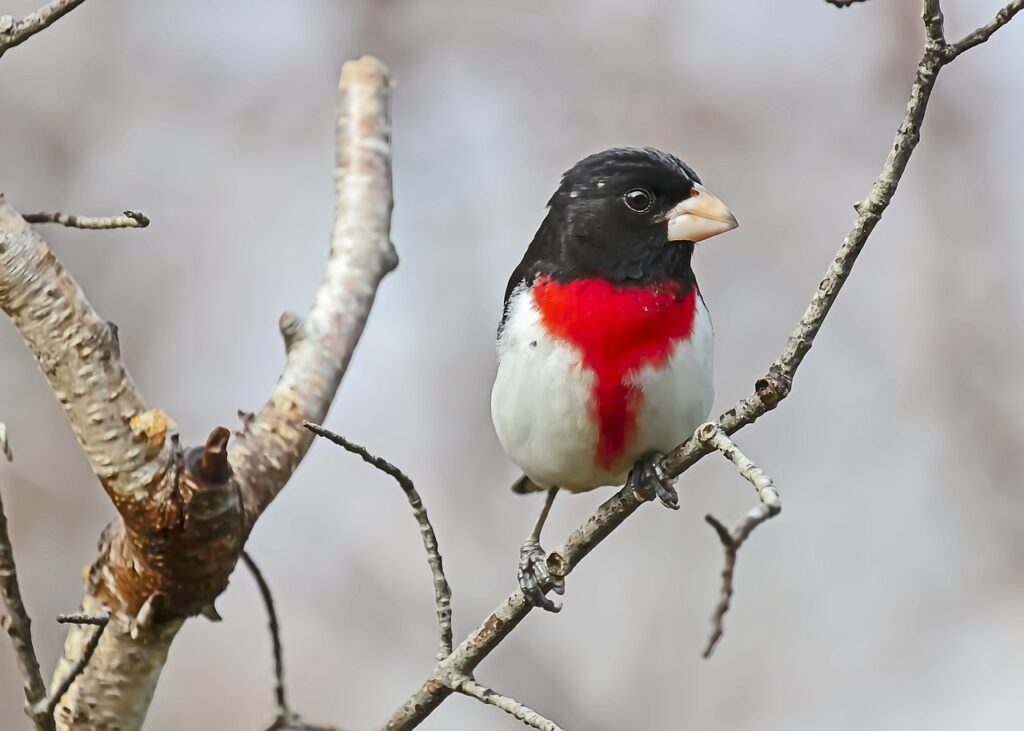
Rose Breasted Grosbeaks are another colorful visitor from their wintering grounds of Southern Mexico and Northern South America. They’re roughly the same size as an American Robin (and have similar calls!), and are fairly common at bird feeders that offer sunflower seeds. Their bright white and red contrasting with black make for a can’t miss color scheme!
The Best Food for Rose Breasted Grosbeaks: Sunflower seeds
They’re likely to visit feeders in the late spring during migration when they need extra energy. Have native berry plants and shrubs in your yard for another chance to attract these birds.

8. Ruby Throated Hummingbird

The Ruby-Throated Hummingbird is the only species you’ll commonly see in the Eastern United States. They arrive in April or May (depending on where you’re located) and migrate back to Central America in the Fall. They beat their wings about 53 times a second, according to the Cornell Bird Lab.
The Best Food for Hummingbirds: Nectar – You can easily make your own hummingbird nectar from home by combining four parts water with one part table sugar. Here’s a short video I made showing how below.
IMPORTANT: You absolutely must completely clean out your hummingbird feeders every other day at minimum. Clean them every day if it’s hot outside or if the feeders are in direct sunlight. The nectar easily starts growing bacteria and mold. This can harm or kill the hummingbird if you aren’t diligent!
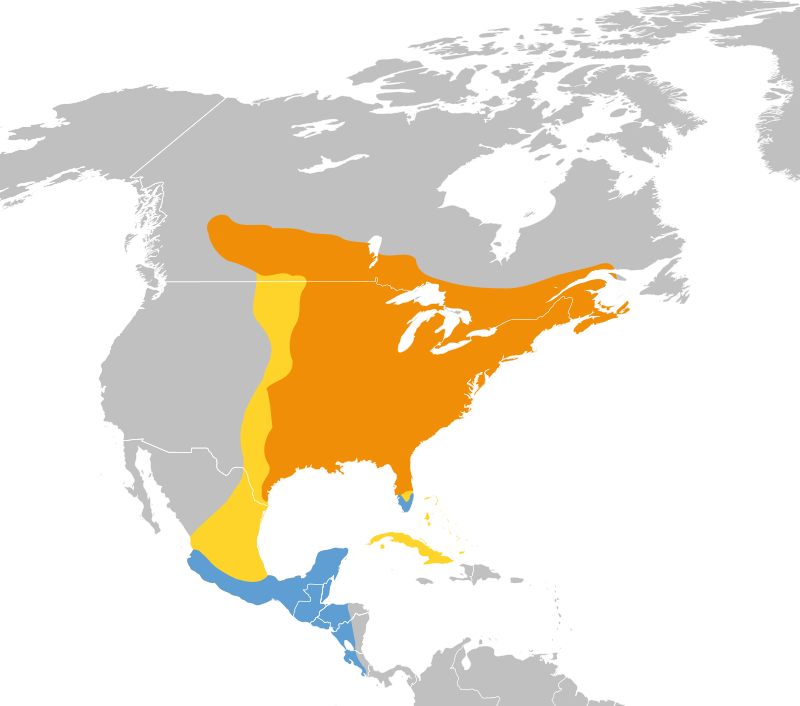
Related Content: 11 of the Best Hummingbird Feeders You Can Buy on Amazon
9. Scarlet Tanager
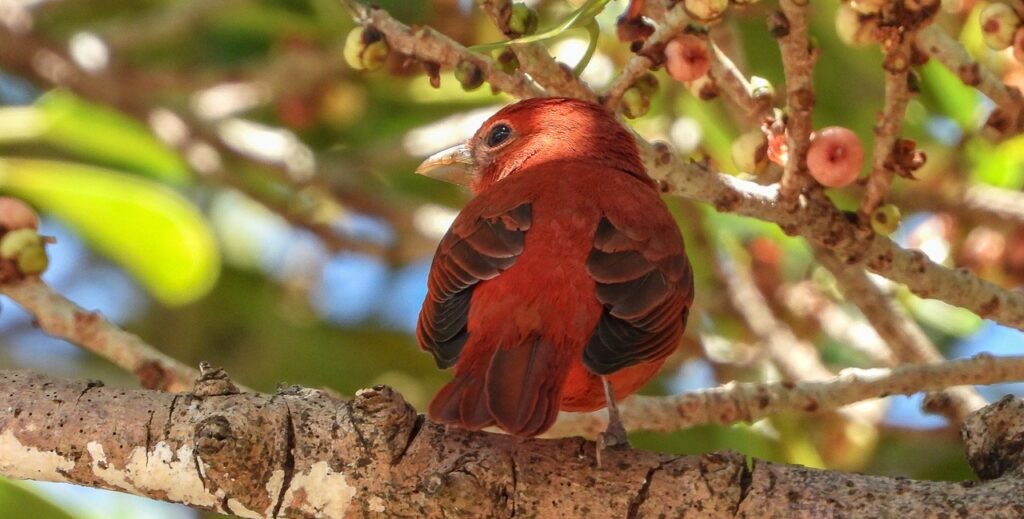
A bright-red and stunning migrant bird from South America, Scarlet Tanagers are viewed by some (like me) to be a top bird on their list to see in the spring and summer at their feeders. These bright beauties usually stay hidden in forest tree tops, but they will visit bird feeders once in a blue moon.
The Cornell Bird Lab describes the call of a Scarlet Tanager to be a raspy Robin-like call.
The Best Food for Scarlet Tanager: I haven’t been fortunate to have had a Scarlet Tanager visit my feeders. I’m told that you have the best shot at spotting one before or after storms in the late spring. Have your feeders stocked with a variety of suet and fruit. It would also be helpful to have berry-producing plants and trees in your yard.

Source: Cephas, Wikipedia
Yellow Rumped Warbler
Yellow Rumped Warblers are also known as “Butter Butts”, no I’m not making this up. You can spot yellow on their heads and, yes, on their butt.
These birds migrate from the Southern United States and Mexico in the spring. You can find them in the edge of trees around your neighborhood or forests, usually searching for insects to eat.
The Best Food for Yellow Rumped Warblers: They’re known to drop by feeders for sunflower seeds and suet on occasion.
Wrapping Up and Sources
I hope you found this image guide fun and helpful! At the end of the day, be sure to keep your bird feeders stocked with a variety of foods in the spring for your best chance to attract these colorful migrant birds.
I’m still awaiting for the elusive Scarlet Tanager, but I have many years of birding ahead of me to spot one in my neighborhood!
Sources:
Disclaimer: Some links found on this page are Amazon affiliate links. If you click an affiliate link and make a purchase, I might earn a commission. As an Amazon Associate I earn from qualifying purchases. (There’s no extra cost to you if you do this).
